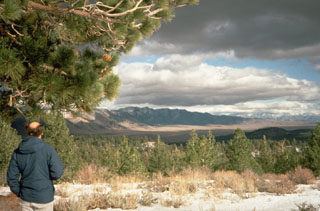Report on Long Valley (United States) — July 1983
Scientific Event Alert Network Bulletin, vol. 8, no. 7 (July 1983)
Managing Editor: Lindsay McClelland.
Long Valley (United States) New collapse pits and fumarole
Please cite this report as:
Global Volcanism Program, 1983. Report on Long Valley (United States) (McClelland, L., ed.). Scientific Event Alert Network Bulletin, 8:7. Smithsonian Institution. https://doi.org/10.5479/si.GVP.SEAN198307-323822
Long Valley
United States
37.7°N, 118.87°W; summit elev. 3390 m
All times are local (unless otherwise noted)
As of early August, no significant earthquake swarms had been detected since 4 June. An average of 2-4 events per day larger than M 1 were recorded in July. Completion of deformation measurements in the caldera is expected at the end of the summer.
The following is from Dartmouth College geologists:
"While conducting an extensive geochemical study of Rn and Hg° concentration at Long Valley, Dartmouth College geologists found evidence of activity in two previously unreported places. Very recent ground breakage (one large collapse pit 3 m long, 2.5 m wide, and 1.5 m deep; another pit 0.5 m in diameter and 0.5 m deep) was found along a fault sag approximately 0.5 km long bearing 340°. The fault is approximately 350 m W of Deer Mountain, the southernmost of the Inyo Domes in the NW part of the caldera (at UTM coordinates 321450 E and 4175800 N). A fumarole located in the Casa Diablo area (just S of the resurgent dome in the S part of the caldera) and associated with older alteration also appears to be previously unreported. New ground breakage may have allowed its formation (at UTM coordinates 333190 E and 4169370 N)."
Geological Summary. The large 17 x 32 km Long Valley caldera east of the central Sierra Nevada Range formed as a result of the voluminous Bishop Tuff eruption about 760,000 years ago. Resurgent doming in the central part of the caldera occurred shortly afterwards, followed by rhyolitic eruptions from the caldera moat and the eruption of rhyodacite from outer ring fracture vents, ending about 50,000 years ago. During early resurgent doming the caldera was filled with a large lake that left strandlines on the caldera walls and the resurgent dome island; the lake eventually drained through the Owens River Gorge. The caldera remains thermally active, with many hot springs and fumaroles, and has had significant deformation, seismicity, and other unrest in recent years. The late-Pleistocene to Holocene Inyo Craters cut the NW topographic rim of the caldera, and along with Mammoth Mountain on the SW topographic rim, are west of the structural caldera and are chemically and tectonically distinct from the Long Valley magmatic system.
Information Contacts: D. Hill, R. Cockerham, USGS, Menlo Park, CA; S. Williams, K. Hudnut, E. Lawrence, J. Lytle, Dartmouth College.

